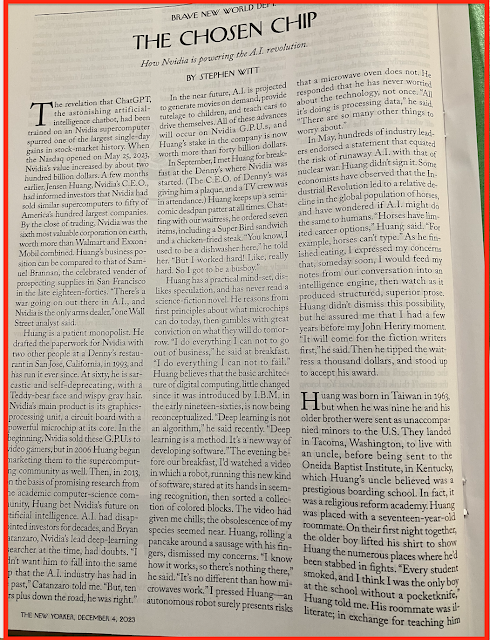Locator: 46361TECH.
Seriously, when did "you" last see / recall a full-feature essay on any business / company in The New Yorker?
I don't think I have one page dedicated to Nvidia. A good place to start.
The fourth industrial revolution. Link here.
Chips, semiconductor: link here.
- Home page for tech: link here.
- The cloud: link here.
- Streaming: link here. Streaming wars.
- Spatial computing: link here.
- Generative AI: link here.
- Apple Silicon: link here.
- Supercomputers: link here.
Near the end of The New Yorker essay:
I asked Huang if he was taking any gambles today that resemble the one he took twenty years ago. He responded immediately with a single word: “Omniverse.” Inspired by the V.R.-architecture gambit, the Omniverse is Nvidia’s attempt to simulate the real world at an extraordinary level of fine-grained detail. Huang has described it as an “industrial metaverse.”
Since 2018, Nvidia’s graphics cards have featured “ray-tracing,” which simulates the way that light bounces off objects to create photorealistic effects. Inside a triangle of frosted glass in Nvidia’s executive meeting center, a product-demo specialist showed me a three-dimensional rendering of a gleaming Japanese ramen shop. As the demo cycled through different points of view, light reflected off the metal counter and steam rose from a bubbling pot of broth. There was nothing to indicate that it wasn’t real.
The specialist then showed me “Diane,” a hyper-realistic digital avatar that speaks five languages. A powerful generative A.I. had studied millions of videos of people to create a composite entity. It was the imperfections that were most affecting—Diane had blackheads on her nose and trace hairs on her upper lip. The only clue that Diane wasn’t truly human was an uncanny shimmer in the whites of her eyes. “We’re working on that,” the specialist said.
Huang’s vision is to unify Nvidia’s computer-graphics research with its generative-A.I. research. As he sees it, image-generation A.I.s will soon be so sophisticated that they will be able to render three-dimensional, inhabitable worlds and populate them with realistic-seeming people. At the same time, language-processing A.I.s will be able to interpret voice commands immediately. (“The programming language of the future will be ‘human,’ ” Huang has said.) Once the technologies are united with ray-tracing, users will be able to speak whole universes into existence. Huang hopes to use such “digital twins” of our own world to safely train robots and self-driving cars. Combined with V.R. technology, the Omniverse could also allow users to inhabit bespoke realities.
Ya think Jensen (Omniverse) and Tim (Vision Pro) are in frequent communication? In Tim's world "ray tracing" is incredibly important and Tim mentions it a lot.
On another note, the other day I mentioned Nvidia and cybersecurity. A top story in the current issue of The New Yorker:

